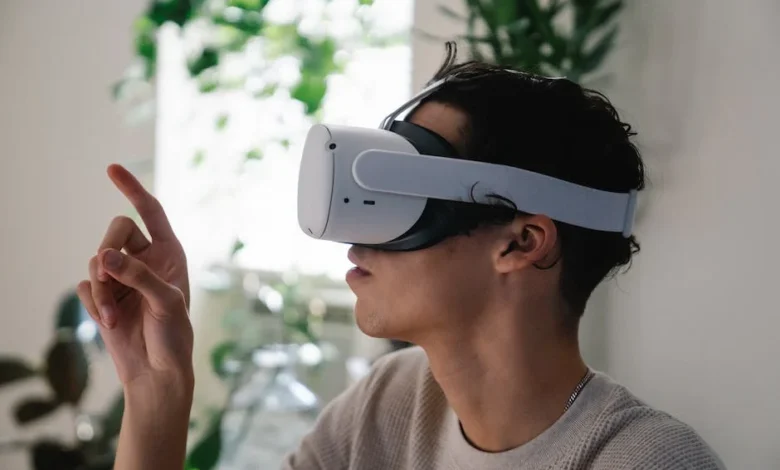How Virtual Reality is Redefining Our Digital Lifestyle :Future of Entertainment

Introduction to virtual reality
Virtual reality (VR) is a technology that creates a simulated environment, allowing users to interact with and experience a different world. VR headsets, such as Oculus Rift and HTC Vive, use high-resolution displays and motion tracking to immerse users in a 3D environment. This technology has the potential to revolutionize entertainment, gaming, education, and even healthcare. With VR, users can feel like they are actually in the digital space, making the experience more engaging and interactive.
Virtual reality in entertainment
Virtual reality has transformed the entertainment industry, offering immersive experiences that transport users to new worlds. From virtual reality video games to 360-degree movies, this technology is redefining how we engage with digital content. Virtual reality headsets like Oculus Rift or HTC Vive have become increasingly popular, allowing users to interact with digital environments in a more realistic and engaging manner. Furthermore, virtual reality is making strides in the realms of virtual concerts, virtual travel experiences, and even virtual theme park rides. As the technology continues to advance, its impact on the future of entertainment is bound to be significant.
Impact of virtual reality on digital lifestyle
Virtual reality is reshaping the way we experience digital entertainment. From immersive gaming experiences to virtual travel and exploration, VR technology is revolutionizing how we engage with digital content. The ability to escape into realistic and interactive virtual environments has opened up new possibilities for entertainment, education, and social interaction. Whether it’s exploring distant lands, interacting with lifelike characters, or participating in virtual events, the impact of VR on our digital lifestyle is undeniable.
Virtual reality technology advancements
Virtual reality technology is advancing rapidly, making it more immersive and accessible to a wider audience. Major technological advancements in this field include higher resolution displays, improved tracking and motion control, and the development of standalone VR headsets. These advancements aim to enhance user experience and reduce the barriers to entry for VR, making it a more compelling and user-friendly form of entertainment.
Applications of virtual reality
Virtual reality is being used in various fields, such as gaming, education, healthcare, and tourism. In gaming, virtual reality provides an immersive and interactive experience for players. In education, it allows for simulations and visualizations that enhance learning. Healthcare professionals use virtual reality for medical training and therapy. Additionally, virtual reality is offering new ways to experience travel destinations through virtual tours and experiences.
Future trends in virtual reality
Virtual reality (VR) is rapidly evolving, shaping the future of entertainment. Here are some key future trends in virtual reality:
- Enhanced Immersion: Future VR experiences will offer even deeper and more realistic immersion, blurring the lines between the virtual and physical worlds.
- Improved Hardware: Advancements in VR hardware will lead to more comfortable, lightweight, and high-resolution devices, making the technology more accessible to a broader audience.
- Social VR: As the technology progresses, collaborative and social VR experiences will become more prevalent, allowing users to interact and connect with others in virtual environments.
- Expanded Applications: VR’s impact will extend beyond gaming and entertainment, with applications in education, training, healthcare, and more.
- Innovation in Content: With the growth of VR, content creators will continue to push boundaries, offering innovative and diverse experiences to captivate audiences.
These trends are set to redefine our digital lifestyle, ushering in a new era of immersive and engaging experiences.
Benefits of virtual reality in entertainment
Virtual reality in entertainment offers an immersive experience, allowing users to feel like they are part of the action. Some benefits include:
- Immersive Experience: VR provides an immersive experience, making users feel like they’re part of the action, creating a more engaging entertainment experience.
- Diverse Content: VR entertainment offers a wide range of content, from gaming to interactive storytelling, providing something for everyone.
- Enhanced Engagement: Users are more engaged with VR content due to its interactive and immersive nature, leading to a deeper level of enjoyment and involvement.
Challenges and limitations
Virtual reality technology still faces challenges and limitations that affect its widespread adoption. While VR devices have become more affordable, there are concerns about the potential health risks, such as motion sickness and eye strain, associated with prolonged use. The need for powerful hardware to support high-quality VR experiences also remains a barrier for many consumers. Moreover, content creation for virtual reality platforms can be complex and costly, limiting the availability of diverse and immersive experiences. As the technology continues to evolve, addressing these challenges will be essential to fully realizing the potential of virtual reality in shaping our digital lifestyle.
Virtual reality and social interactions
Virtual reality is changing the way we interact with others. It allows us to engage in immersive social experiences with people from all over the world. Using VR, we can attend virtual events, play games, and even create art together in shared virtual spaces. This technology has the potential to revolutionize the way we connect with others and may reshape the future of social interactions.
Conclusion: Shaping the future digital lifestyle
Virtual reality is revolutionizing the way we experience entertainment. As technology continues to evolve, VR has the potential to completely reshape our digital lifestyle, offering immersive experiences that were once unimaginable. From gaming to education to social interaction, virtual reality is unlocking new possibilities and pushing the boundaries of what is possible in the digital world. As more industries embrace this innovative technology, we can look forward to a future where virtual reality plays a central role in how we engage with the digital world.




